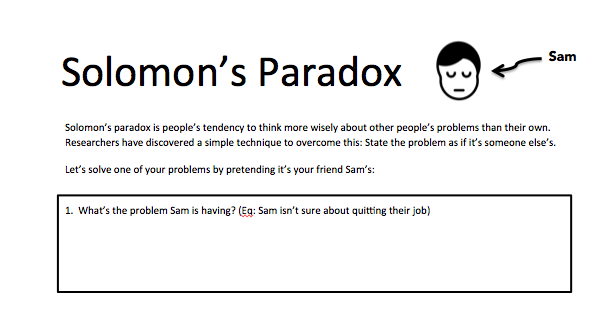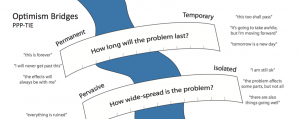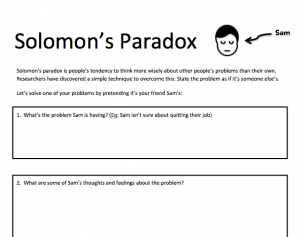Emotional intelligence can seem like a squishy concept. It sounds great… but how do you actually practice and improve yours?
Here are 7 practical tips + resources to help you cultivate emotional intelligence.
1. The Emotoscope Feeling Chart. What’s the purpose of emotions in general? They act as a sort of alarm system / filter / guide for us as we go through the world. An emotion (1) focuses our attention and (2) motivates us toward a specific course of action. And every emotion serves its own niche. Fear focuses our attention on a perceived threat and motivates us to protect ourselves. Joy focuses our attention on an opportunity and motivates us to take note of what really matters to us. An often overlooked way to cultivate emotional intelligence is to understand these ins and outs of every emotion – it’s the EQ skill of enhancing emotional literacy. And the Emotoscope Feeling Chart is a resource specifically designed to cultivate emotional literacy. It breaks down the focus and purpose of dozens of emotions. Take, for example, feeling overwhelmed. I often overcommit and find myself feeling overwhelmed. It’s easy to wallow in that feeling and say, “I feel overwhelmed because of all these reasons: x, y and z.” The beauty of the Emotoscope Feeling Chart is that it provides insight into what that emotion is telling me to do. In the case of feeling overwhelmed, it’s to prioritize. What’s the message of anxiety? Check out the Emotoscope Chart below to find out. This is all part of becoming fluent in the language of emotions. Knowing the word for a feeling is step one, but defining that feeling and it’s purpose is the next step. The Emotoscope Feeling Chart is the perfect resource to help you master that step and cultivate emotional intelligence.

2. Rose, Bud, Thorn. Have you ever heard of Rose, Bud Thorn? It’s a fun, simple game that can be useful to start recognizing your recurring thought and behavior patterns. You and a friend, or a journal, tell each other your day’s best thing (rose), worst thing (thorn), and what you’re looking forward to (bud). I wrote my Roses, Buds and Thorns in my journal for a week, and then I looked at all the thorns and what they had in common. I found a pattern of my thorns being perceived social rejections – friends who had to cancel, couldn’t hang out, or didn’t reach out. The game helped me recognize a pattern of mine: When I feel unwanted, I get easily depressed. I could also look at my Roses and recognize patterns. When I spend a lot of time outdoors, I tend to be very happy. It’s valuable emotional data about what to do more of or less of, and a great way to cultivate emotional intelligence. Josh Freedman discusses the neuroscience of forming patterns and other tips for beginning to recognize them in this video:


3. The Rule of 3. The ability to exercise optimism is one of the core EQ skills in the Six Seconds Model of EQ. But exercising optimism is not simply wishing for the best. It’s not passive. It’s a form of mental and emotional labor where you work to generate, or see, new options. Josh Freedman, Six Seconds’ CEO, defines exercising optimism as “Knowing there are possibilities even when you can’t see them.” One trick to hone your optimism is to follow the Rule of 3 – when faced with a dilemma or decision, generate at least 3 options to consider. Research from Ohio State University has found that this causes the quality of our decisions to increase pretty dramatically. Dr. Therese Houston, a decision making expert and author of How Women Decide, sums up the problem this way: ““All too often we only give ourselves one option and we fool ourselves into thinking it’s actually two. Should I do this or not? There’s really only one option on the table – I’m going to make this change or I’m going to stay put. If you give yourself three options, it gets you thinking outside the box.” So to cultivate emotional intelligence, generate at least 3 options.
4. TIE. Six Seconds’ President, Anabel Jensen, went through an extremely difficult divorce many years ago. It felt like her whole world was coming crashing down. It’s in hard times like these when the ability to exercise optimism is the most essential – and the most difficult. This acronym, TIE, is all about exercising optimism when times are tough. It stands for Temporary, Isolated and Effort, and it helped Anabel and her son respond to this adversity in a healthy, optimistic manner. You can read her beautiful story and an in-depth description of TIE here. And you can download a free TIE worksheet to take you through the process by clicking on the button below.

5. Naming Emotions. Naming your emotions is a remarkably effective method for making them less intense. Just simply remembering to say how you’re feeling, like “I am angry / sad / anxious, etc…”, has been found to be a crucial first step in navigating emotions. Why? It seems to bridge the gap between thoughts and feelings. It calms the amygdala, and activates the prefrontal cortex. It calms down our emotional response so we have an opening, an opportunity, to combine our thinking and feeling more effectively – and that is what EQ is all about. Dr. Barabara Fatum describes the neuroscience behind this phenomenon beautifully in the video to the right. So next time you are feeling a difficult emotion, start by labeling it: I am angry, or sad, or anxious. Just tell it like it is.
6. More Empathy, Less Sympathy. Recognizing and appropriately responding to others’ emotions is what Six Seconds calls increasing empathy. To do this effectively, a high level tip is to understand the subtle differences between empathy and sympathy. Because while they are similar, there are crucial differences that lead to very different outcomes. What’s the difference? Basically, emotional versus cognitive involvement. Empathy means experiencing someone else’s suffering. It’s putting yourself in that person’s shoes and really feeling their pain with them. Sympathy, on the other hand, means understanding someone else’s suffering. It keeps a little more distance than really feeling it. And not surprisingly, sympathetic responses often stay on this cognitive level – offering advice, reasons to look on the bright side, etc. Whereas an empathetic response often means just sitting there and being with that person, validating what they’re feeling. Practicing just sitting there in the muck with someone is great way to cultivate emotional intelligence. This RSA animate, animated by Brené Brown, describes the difference perfectly.
7. Solomon’s Paradox. Did you know that we all have a tendency to reason more wisely about other people’s problems than our own? It’s known as Solomon’s Paradox. Research at the University of Waterloo in Canada has proven it to be true – and found that a simple self-distancing technique can open up that wisdom to be used on yourself. So one trick to cultivate emotional intelligence is to pretend like you’re making a decision for a friend or observing your life, which unlocks some key aspects of EQ. You can read more about the Waterloo experiments here. And you can download a free worksheet that walks you through an effective self-distancing technique by clicking on the button below.

What’s new in emotional intelligence?
From Enemy to Ally: How Eric Pennington Changed His Relationship with His Own Emotions – and Found His Life’s Purpose
How emotional intelligence helped Eric Pennington transform corporate life setbacks into strengths – and find purpose in both work and life.
Helping Others Achieve Overall Well-being and Healthy Connections: How Emotional Intelligence Guided Pamela Barker’s Career Path Growth
Pamela Barker’s journey began with healing bodies, but it was her discovery of emotional intelligence that unlocked her true purpose: helping others achieve overall well-being and healthy connections. From her days as a physical therapist to becoming a passionate EQ coach, Pamela’s story is one of transformation, resilience, and the power of connection. Her experience shows that real change starts from within.
Harnessing Emotional Intelligence: How Sara Canna Supports Employees and Transforms People’s Lives at the World Health Organization (WHO)
Emotional intelligence is more than just a buzzword—it’s a transformative tool that can reshape how we navigate challenges, build relationships, and thrive in demanding environments. Discover how Sara Canna brought EQ to the World Health Organization, empowering employees to manage change, stress, and personal growth.
From Corporate Consultant to Coach: Elise Jones’ Emotional Intelligence Journey-Voices from the Network
Elise Jones transformed her career by embracing emotional intelligence, shifting from a corporate consultant to a passionate EQ Coach. Through authentic connections, she found deeper fulfilment, proving that strong relationships are key to a happier, more meaningful life.
Want to Manage Your Emotions More Effectively? Find Time to Journal About Challenging Experiences
Daily journaling to reframe unpleasant events can significantly reduce depressive symptoms, lessen stress, and increase life satisfaction.
A Journey through Empathy & Optimism: Amy Jimison in Voices from the Network
When you feel stuck and can’t see a way out, how do you navigate change? Certified Coach and leadership expert Amy Jimison shares her approach.
- Pursue Noble Goals in the Six Seconds Model of EQ - July 29, 2023
- Increase Empathy in the Six Seconds Model of EQ - July 26, 2023
- Exercise Optimism - July 24, 2023







 TIE Optimism Worksheet
TIE Optimism Worksheet
Hello can you please send me the link to the emotosocope chart? I’m having an issue downloading it with the link provided. Thank you
Hello can you please send me the link to the emotosocope chart? I’m having an issue downloading it with the link provided. Thanks
Hi Leslie, I just sent the Emotoscope Feeling Chart to [email protected]. I apologize for the technical issue; we are working to resolve it. Have a good day and enjoy the EFC!
Hi,
Very interesting article, thanks for sharing.
However I was not able to download the Solomon’s Paradox worksheet.
Appreciate if your support.
Thanks!
Hi Omar, I apologize for the trouble downloading the worksheet. It is working now, and I went ahead and forwarded it to your email. Thank you for reading!
Thanks for another interesting EQ article. I’m attempting to download Solomon’s Paradox worksheet, but it keeps tripping me back to this page. Could you please help.
Can’t download TIE and Solomon’s Paradox worksheets as the pages reloads itself without any other action. I think the links for them are broken.
Hi Marianna, I’ve fixed the TIE worksheet form & the Solomon’s Paradox seems to be working for me. Please let me know if you are still having an issue with either & I will look into it. Thanks!
I’m having the same issue with the emotochart.
I am sorry to hear that, Priti. I emailed you the Emotoscope Feeling Chart and I am working to fix the issue.
Hello, I have been trying to download the Emotoscope Feeling Chart but I am able to type in the boxes and am sent back to this page within a few seconds.
Hi Julia, thanks for alerting us. I have fixed the technical glitch and forwarded you the Emotoscope Feeling Chart.
Hi Michael, thank you so much for these resources – I am so grateful to have stumbled on your website this morning!
Hi Lizelle! No problem. It’s my pleasure and I am glad you stumbled upon our website. Have you signed up for our weekly newsletter? It’s a weekly email with the latest articles and opportunities to get involved with Six Seconds. If you want help or want to know how to get involved, feel free to start a conversation. My email address is [email protected].
Need your help to lead peaceful, fearless confident life
Hi Laxmi, we are happy to help you develop your emotional intelligence. Let me know how you would like to get involved!